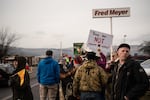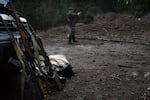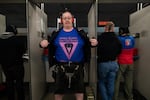At Oregon's Columbia River Gorge Women's March in January, Ross Eliot brought up the rear, more concerned with what might be happening behind the group than keeping pace with the many chants from the roughly 250-person crowd.
Eliot was there as security. He was looking over his shoulder for anyone who might attack the group.
With the threat of right-wing violence on the rise, Eliot is among a growing number of activists on the left who are taking a page out of the 1960s civil rights movement: armed self-defense.
That threat was on Eliot's mind at the march. Tucked under his army green jacket was a Springfield Armory XD-S 9 mm handgun.

Ross Eliot, a leftist activist and proponent for armed self-defense, looks behind the Women’s March for any possible threats on Jan. 19, 2019 in The Dalles, Ore.
Jonathan Levinson / OPB
Eliot has been a leftist activist in the Pacific Northwest and proponent of armed self-defense since the 1990s.
He said his philosophy is informed by his early experience as an activist in Seattle.
"It was just sort of the standard procedure that you should know about labor history, you should know about working-class issues," he said. "And it would be expected that you would also know how to use a rifle."
Eliot said spontaneous violence is a serious concern at demonstrations like the Women's March. He pointed to the white supremacist who killed two men on a Portland train in 2017 and the neo-Nazi who killed someone when he drove his car into a crowd of protesters in Charlottesville.
"There's been a lot of people on the far right talking about carrying out attacks like that," he said. "So it's something that you absolutely want to be on the lookout for."

Ross Eliot, an activist and proponent of armed self-defense, fires a handgun on Feb. 2, 2019 in Hood River, Ore.
Jonathan Levinson / OPB
What If You Can't Call The Police?
Rosie Strange has been on the receiving end of those threats.
Strange is an activist in The Dalles, Oregon, a small town about 90 minutes east of Portland. Last summer, she was eating breakfast at a popular pancake joint in town. A few tables away was Bryan Brandenburg, who at the time was the jail commander at NORCOR, a regional jail in The Dalles. The jail also houses Immigration and Customs Enforcement (ICE) detainees, which critics say violates the state's sanctuary law. (A Wasco County judge recently ruled the jail's contract with ICE doesn't violate the sanctuary law, but some of the jail's practices do.)
Strange, whose car is covered in political bumper stickers, usually has protest signs stashed in her trunk. She said she got a sign from her car that said "De-ICE NORCOR" and set it on her table while she ate.
Later that day, she started receiving messages from friends.
The Sherman County sheriff, who uses NORCOR to house local inmates, had posted a picture of her from that morning on the department's official Facebook page saying her actions were "disgusting."
The vitriol came pouring in. She received hundreds of threats and attacks in the comments.
"Including," she said, "that I should be shot in front of my children."

Rosie Strange sits in a restaurant after the Women’s March on Jan. 19, 2019 in The Dalles, Ore. Her left arm says "FEMINIST" and her right arm has an anti-fascist symbol on it.
Jonathan Levinson / OPB
In the photo, her face is pixelated, but The Dalles is a small community and she has bright pink hair and tattoos. She's easily identifiable and said the experience shattered her sense of security.
Sherman County Sheriff Brad Lohrey never accused Strange of violating any law and he acknowledged that she had asked the department to take the post down. Lohrey said he would only do so if Strange apologizes to Brandenburg.
Strange said she no longer feels like she can rely on the police to protect her.
"It's led me to make really serious decisions about my safety for my family," she said, "And I feel that I can never ever call the sheriff again."
So, she got a gun.

Ross Eliot (center, left) and Rosie Strange (right) take target practice with other activists on Feb. 2, 2019 in Hood River, Ore.
Jonathan Levinson / OPB
Strange knows the statistics that say her gun is more likely to be used against her than to protect her. But she said those statistics lack nuance.
"They're still not able to cover that gap for people like me. Women of color, activists," she explained.
Strange feels relying on police to protect you is a privilege.
"I refuse to wait for a police officer to get to make the decision of how dangerous my white assailant is," she said, referring to a past domestic violence incident when she said the police took the word of her white abuser over her own.
The Civil Rights Movement
There's an old trope in gun control circles: If you're being robbed, instead of playing the hero with a gun it's much safer to simply cooperate. Give them what they want.
"Well what if they want you dead?" asked Fordham University School of Law professor Nicholas Johnson.
Johnson is an expert in firearms law and wrote "Negroes and the Gun," a book on the history of armed self-defense in the black community.
He said the civil rights movement is full of examples.
In a 1964 interview, Malcolm X said, "In the face of the brutality that our people encounter, it's not unjust to teach a negro to have a rifle or a shotgun in his house."
And in 1963, civil rights activist Hartman Turnbow used a semi-automatic rifle to defend his home after it was firebombed.
Turnbow later said, "I wasn't being non-non-violent, I was just protecting my family."
Johnson said even the NAACP cut its teeth defending black people who had used guns in self-defense. For example, the organization helped defend Ossian Sweet in 1925 after he was charged with murder for defending himself against a white mob that was angry he had moved into their neighborhood.
In fact, Johnson said almost every episode in the civil rights movement has some aspect of armed self-defense to it. And, he said, that makes sense.
According to Johnson's reasoning, people who think they have a firm stake in the existing authority structure will feel safe trusting their security to the state.
"But if you think the state is going to fail," Johnson said, "then I would expect those people to think, 'Oh, private self-defense may be of value.'"

Guns are splayed out at the gun range during The Liberal Gun Club’s winter range day on Jan. 26, 2019 in Portland, Ore.
Jonathan Levinson / OPB
'Sheepdogs'
On a Saturday afternoon in January, the Portland chapter of the Liberal Gun Club hosted a winter range day. And while everyone there enjoyed shooting guns, not everyone agreed on their role in society.
Phil Phillips and his family moved to Oregon three years ago from Chattanooga, Tennessee.
Wearing a "Make Fascists Afraid Again" hat, Phillips laughed and said, "I jokingly say we moved here seeking political asylum."
Phillips said he loves target shooting, but isn't convinced that people should own guns for security.
"This is a very safe environment," he explained. "I do not believe guns need to be kept in the home for self-defense."
And for many Oregonians, Phillips may be right.
According to 2014 U.S. Department of Justice data, Oregon has the 11th lowest violent crime rate in the country.
But for marginalized populations, people who don't feel safe calling the police, guns look a little different.
L.A. Watson-Haley was there too, firing a massive .44 magnum revolver. The enormous pistol matches its owner. Watson-Haley towers over the other shooters.
He wore a kilt and a T-shirt that said "armed queers don't get bashed."

L.A. Watson-Haley shows off his new T-shirt at The Liberal Gun Club’s winter range day on Jan. 26, 2019 in Portland, Ore.
Jonathan Levinson / OPB
But Watson-Haley, who said he has been shot at before, doesn't carry a firearm to protect only himself. He said there are three groups of people in society: wolves, sheep and sheepdogs.
"I'm a sheepdog," he explained. "I'd rather be there to at least try to make stand, because there's too many wolves in this world, and way too many sheep."
He said he'll stand in the middle if he has to.
Guns & America is a public media reporting project on the role of guns in American life.
Editor's note: A previous version of this story misidentified the location of the Jan. 19, 2019, Women’s March in a photo caption.

